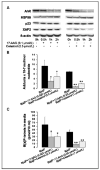Heat shock protein 90 inhibitors suppress aryl hydrocarbon receptor-mediated activation of CYP1A1 and CYP1B1 transcription and DNA adduct formation
- PMID: 19138996
- PMCID: PMC2680610
- DOI: 10.1158/1940-6207.CAPR-08-0149
Heat shock protein 90 inhibitors suppress aryl hydrocarbon receptor-mediated activation of CYP1A1 and CYP1B1 transcription and DNA adduct formation
Retraction in
-
Retraction: HSP90 Inhibitors Suppress Aryl Hydrocarbon Receptor-Mediated Activation of CYP1A1 and CYP1B1 Transcription and DNA Adduct Formation.Cancer Prev Res (Phila). 2022 Jun 2;15(6):415. doi: 10.1158/1940-6207.CAPR-22-0200. Cancer Prev Res (Phila). 2022. PMID: 35652225 Free PMC article. No abstract available.
Abstract
The aryl hydrocarbon receptor (AhR), a client protein of heat shock protein 90 (HSP90), plays a significant role in polycyclic aromatic hydrocarbon (PAH)-induced carcinogenesis. Tobacco smoke, a source of PAHs, activates the AhR, leading to enhanced transcription of CYP1A1 and CYP1B1, which encode proteins that convert PAHs to genotoxic metabolites. The main objectives of this study were to determine whether HSP90 inhibitors suppress PAH-mediated induction of CYP1A1 and CYP1B1 or block benzo(a)pyrene [B(a)P]-induced formation of DNA adducts. Treatment of cell lines derived from oral leukoplakia (MSK-Leuk1) or esophageal squamous cell carcinoma (KYSE450) with a saline extract of tobacco smoke, B(a)P, or dioxin induced CYP1A1 and CYP1B1 transcription, resulting in enhanced levels of message and protein. Inhibitors of HSP90 [17-allylamino-17-demethoxygeldanamycin (17-AAG); celastrol] suppressed these inductive effects of PAHs. Treatment with 17-AAG and celastrol also caused a rapid and marked decrease in amounts of AhR protein without modulating levels of HSP90. The formation of B(a)P-induced DNA adducts in MSK-Leuk1 cells was inhibited by 17-AAG, celastrol, and alpha-naphthoflavone, a known AhR antagonist. The reduction in B(a)P-induced DNA adducts was due, at least in part, to reduced metabolic activation of B(a)P. Collectively, these results suggest that 17-AAG and celastrol, inhibitors of HSP90, suppress the activation of AhR-dependent gene expression, leading, in turn, to reduced formation of B(a)P-induced DNA adducts. Inhibitors of HSP90 may have a role in chemoprevention in addition to cancer therapy.
Figures






Comment in
-
Findings of Research Misconduct.Fed Regist. 2023 Sep 13;88(176):62800-62803. Fed Regist. 2023. PMID: 37736072 Free PMC article. No abstract available.
-
Findings of Research Misconduct.Fed Regist. 2023 Sep 13;88(176):62803-62807. Fed Regist. 2023. PMID: 37736073 Free PMC article. No abstract available.
References
-
- Gu YZ, Hogenesch JB, Bradfield CA. The PAS superfamily: sensors of environmental and developmental signals. Annu Rev Pharmacol Toxicol. 2000;40:519–61. - PubMed
-
- Poland A, Glover E, Kende AS. Stereospecific, high affinity binding of 2,3,7,8-tetrachlorodibenzo-p-dioxin by hepatic cytosol. J Biol Chem. 1976;251:4936–46. - PubMed
-
- Bock KW, Köhle C. Ah receptor: dioxin-mediated toxic responses as hints to deregulated physiologic functions. Biochem Pharmacol. 2006;72:393–404. - PubMed
-
- Moennikes O, Loeppen S, Buchmann A, et al. A constitutively active dioxin/aryl hydrocarbon receptor promotes hepatocarcinogenesis in mice. Cancer Res. 2004;64:4707–10. - PubMed
Publication types
MeSH terms
Substances
Grants and funding
LinkOut - more resources
Full Text Sources

